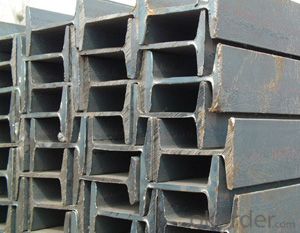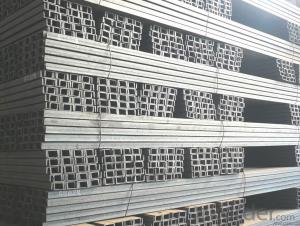Steel U Channel With High Tensile Strength
- Loading Port:
- China main port
- Payment Terms:
- TT or LC
- Min Order Qty:
- 50 m.t.
- Supply Capability:
- 50000 m.t./month
OKorder Service Pledge
OKorder Financial Service
You Might Also Like
Description
In the production of steel products, steel is molded and reshaped with different machinery at different temperatures. One process is steel rolling, which involves metal stock passing through a pair of rolls. Rolling produces flat steel sheets of a specific thickness, and the process is classified according to the temperature at which the metal is rolled. If the temperature of the metal is above its recrystallization temperature, or the temperature at which the grain structure of the metal can be altered, then the process is termed as hot rolling. If the temperature of the metal is below its recrystallization temperature, the process is termed as cold rolling.
Like cold rolling, cold drawing is performed at room temperature, but instead of producing a flat object like a coke can, cold drawing makes steel into the form of a wire like the spokes of a wheel or a paper clip. To start the process, Steel is usual hammered and rolled so that it can be fit through a die; a tool that turns the steel mass into a wire. The room temperature steel is pulled through the die which reshapes it into a thinner shape while maintaining the same volume. It is similar to the idea of syrup flowing out of a bottle through a tube in that it changes shape but not volume, but instead of squeezing the metal, it is pulled out. In order to get the wire down to the right diameter, it usually requires more than one pass through different dies.
Chemical Compostion
Grade | Element(%) | |||
C | Mn | P | S | |
SS330 | -- | -- | ≦0.050 | ≦0.050 |
SS400 | ||||
SS490 | ||||
SS540 | ≦0.30 | ≦1.60 | ≦0.040 | ≦0.040 |
Usage/Applications
Channel Steel is usually used for building structure, vehicle manufacturing and other industrial structure and often used with i beam.
In details, the channel steel belongs to carbon structural steel which is applied to in the field of construction and machinery. The channel steel is usually used for arch-itechtural structure, and they could be welded in order to support or hang a vari-ety of facilities. They are also usually used in combination with I beam. Generally,the channel steel must possess perfect welding property, riveting property and mechanical property and so on.
FAQ:
Q1: Why buy Materials & Equipment from OKorder.com?
A1: All products offered byOKorder.com are carefully selected from China's most reliable manufacturing enterprises. Through its ISO certifications, OKorder.com adheres to the highest standards and a commitment to supply chain safety and customer satisfaction.
Q2: How do we guarantee the quality of our products?
A2: We have established an advanced quality management system which conducts strict quality tests at every step, from raw materials to the final product. At the same time, we provide extensive follow-up service assurances as required.
Q4: What makes stainless steel stainless?
A4: Stainless steel must contain at least 10.5 % chromium. It is this element that reacts with the oxygen in the air to form a complex chrome-oxide surface layer that is invisible but strong enough to prevent further oxygen from "staining" (rusting) the surface. Higher levels of chromium and the addition of other alloying elements such as nickel and molybdenum enhance this surface layer and improve the corrosion resistance of the stainless material.


- Q:Can steel channels be used for structural support?
- Yes, steel channels can be used for structural support. Steel channels are commonly used in construction as they provide strength and durability. They are often used in buildings, bridges, and other structures to provide support and stability. Steel channels are designed to distribute the weight and load evenly, making them ideal for structural support. Additionally, they are versatile and can be easily customized to meet specific design requirements. Overall, steel channels are a reliable and effective choice for providing structural support in various construction projects.
- Q:How do steel channels contribute to the stability of a structure?
- Steel channels contribute to the stability of a structure by providing support and reinforcement. They are often used as beams or columns to distribute the weight and load of the structure evenly, preventing excessive deflection or collapse. The shape and strength of steel channels allow them to resist bending or twisting forces, enhancing the overall stability and structural integrity of the building.
- Q:Can steel channels be used in bridge construction?
- Yes, steel channels can be used in bridge construction. Steel channels have high strength and stiffness properties, making them suitable for carrying heavy loads and providing structural support in bridge construction projects. Their versatility and durability make them a commonly used component in bridge construction.
- Q:Hello, I have a question to ask you, do a steel hoop, the outer diameter of 1688MM, with 8# steel roll, want to ask next to the long material, 8# channel 43, formula I for (1688-43) *3.14159=5168mm, this material, placed above the rolling machine to roll how, outside diameter it is more than 1688 Oh, I would like to ask, feeding formula should start rolling steel...Is it possible to stretch the roll with a profile bending machine? Can you recommend 1-2 units? It's best to have the approximate price. I'd like to consider whether I can buy one. Thank you
- Count the amount, and in turn count how much it should be minus 1688, and then do it. Or leave a little margin, roll it repaired.
- Q:Are steel channels customizable in terms of size and shape?
- Yes, steel channels are indeed customizable in terms of size and shape. Steel channels are versatile structural components that can be modified to meet specific requirements and design needs. They can be customized in terms of length, width, depth, and even the shape of the cross-section. This flexibility allows for the creation of steel channels with various profiles, such as C-channels, U-channels, or even more complex shapes like Z-channels. Customization of steel channels enables engineers and designers to tailor the structural elements to fit specific applications, ensuring optimal performance and efficiency in various industries, including construction, manufacturing, and infrastructure.
- Q:What does "channel 160*60*20*2.5" mean in steel roof trusses? What is the specific weight?
- Steel structure is mainly made of steel material, and it is one of the main types of building structure. The structure is mainly composed of steel beams and steel plates, such as steel beams, steel columns, steel trusses and so on. Each component or component is usually connected with welds, bolts or rivets. Because of its light weight and simple construction, it is widely used in large factories, stadiums, super high-rise and other fields.
- Q:Can steel channels be used for stair treads?
- Yes, steel channels can be used for stair treads. Steel channels provide strength and durability, making them suitable for supporting the weight and traffic of stair treads. Additionally, steel channels can be easily fabricated and customized to meet the specific requirements of staircases.
- Q:Can steel channels be used in the aerospace parts manufacturing industry?
- Yes, steel channels can be used in the aerospace parts manufacturing industry. Steel channels are often used in the construction of aircraft structures and components due to their high strength, durability, and resistance to deformation. They can be used in various applications such as framing, support structures, and reinforcement for critical aerospace parts. Steel channels provide structural integrity and stability, allowing for the safe and reliable operation of aerospace vehicles. Additionally, steel channels can be easily fabricated and welded, making them an ideal choice for the aerospace industry, where precision and quality are of utmost importance.
- Q:What is the significance of the dimensions of steel channels?
- The importance of steel channel dimensions can be attributed to several factors. To begin with, the structural integrity and strength of a steel channel depend on its dimensions. Steel channels are commonly employed in construction and engineering projects to offer support and stability. By determining the height, width, and thickness, these dimensions ascertain the channel's ability to withstand weight and loads without distortion or collapse. Consequently, selecting appropriate dimensions is crucial to guarantee the channel's effective performance in its intended function. Moreover, the dimensions of steel channels also play a role in their versatility and compatibility with other building components. Standardized dimensions are often preferred as they seamlessly fit into existing structural systems, thus streamlining construction and assembly. Additionally, the dimensions of steel channels must be compatible with other materials or components, like bolts or fasteners. Ensuring a proper match of dimensions establishes a secure and smooth connection between various elements, thereby enhancing the overall stability and durability of the structure. Furthermore, the dimensions of steel channels can influence their cost and availability. Manufacturing processes may vary depending on the dimensions, which in turn affect production costs. Additionally, certain dimensions are more commonly produced or stocked by suppliers, making them more readily available and cost-effective compared to customized or non-standard sizes. Lastly, the dimensions of steel channels can also have aesthetic considerations. In architectural and design applications, the dimensions of steel channels contribute to the overall appearance and style of a structure. The proportions and arrangements of channels can create visual interest, specific architectural effects, or align with particular design styles or preferences. In summary, the importance of steel channel dimensions lies in their impact on structural integrity, versatility, compatibility, cost, availability, and aesthetics. Thoughtful consideration of these dimensions ensures that steel channels meet the requirements of a project, providing a robust and dependable support system for various applications.
1. Manufacturer Overview |
|
|---|---|
| Location | |
| Year Established | |
| Annual Output Value | |
| Main Markets | |
| Company Certifications | |
2. Manufacturer Certificates |
|
|---|---|
| a) Certification Name | |
| Range | |
| Reference | |
| Validity Period | |
3. Manufacturer Capability |
|
|---|---|
| a)Trade Capacity | |
| Nearest Port | |
| Export Percentage | |
| No.of Employees in Trade Department | |
| Language Spoken: | |
| b)Factory Information | |
| Factory Size: | |
| No. of Production Lines | |
| Contract Manufacturing | |
| Product Price Range | |
Send your message to us
Steel U Channel With High Tensile Strength
- Loading Port:
- China main port
- Payment Terms:
- TT or LC
- Min Order Qty:
- 50 m.t.
- Supply Capability:
- 50000 m.t./month
OKorder Service Pledge
OKorder Financial Service
Similar products
New products
Hot products
Related keywords



























